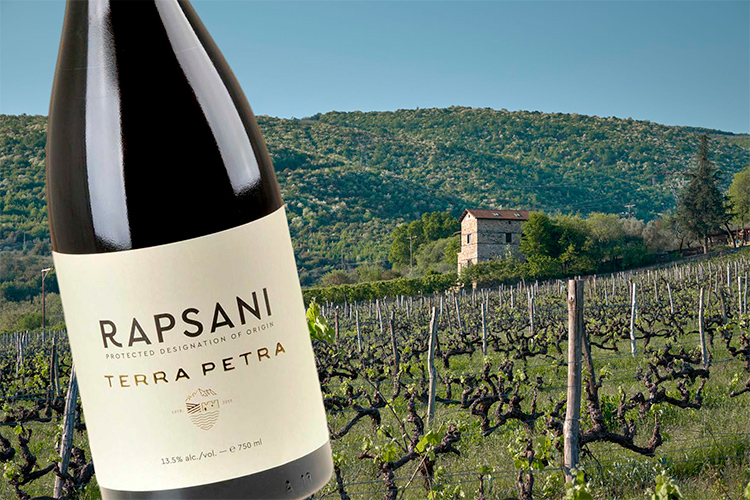A red blend from Rapsani (Thessaly, Greece) was my favourite in a recent wine tasting in London. Terra Petra by Thymiopoulos Vineyards has Burgundian quality and an outstanding value-for-money ratio. Great Greek wines have never been so alluring
At the end of February 2023, I attended the ‘Catch a Rising Star’ wine tasting hosted by The Wine Society. The walkaround event was held at the grand Chelsea Old Town Hall, located in the affluent area of South Kensington in London.
When I sipped Rapsani Terra Petra by Thymiopoulos Vineyards, I immediately realised I had indeed caught a star. This red blend from the foothills of Mount Olympus in Greece soon became my favourite of the evening. I confess that I could not leave the event without returning to the Greek wine stand one more time to taste Rapsani Terra Petra – something I rarely do.
I am very happy to share my recent discovery, Rapsani Terra Petra by Thymiopoulos Vineyards, with my readers. Below is an introduction to the wine’s origin, grapes and producer. I then conclude my article with detailed tasting notes. Enjoy!
Where this wine is from: Rapsani
Rapsani identifies as both a town and a Protected Denomination of Origin (PDO) for Greek wine. The district lies on the southern foothills of Mount Olympus, one of the most renowned landmarks of mainland Greece. Rapsani is nestled in the Thessaly region, between Macedonia in the north and Central Greece in the south.

The landscape in Raspani features hills with Mediterranean shrubs dotted alongside winding roads. Groves alternate with olive trees, vineyards and spectacular views of the Aegean Sea.
In terms of terroir, Rapsani has a Mediterranean climate with sunny and warm days. The Aegean Sea on the east and the mountainous peaks in the north have a mitigating effect, reducing temperatures and bringing fresh breezes.
Across the district altitude can vary a lot: Rapsani’s vineyards cover slopes which range between 250 and 750 metres above sea level. Differences in altitude mean that grapes grown at specific elevations ripen at different rates and vary in style and aromatic profiles (I explain how in my past article Why does my wine taste like this? Climatic factors). Ultimately, these variations provide winemakers with more blending options when they craft their wines.
The grapes: Xinomavro, Stavroto and Krasato
With its warm and dry climate, Rapsani’s terroir is naturally suited to red wine production. It is therefore no surprise that the Rapsani PDO appellation rules only allow reds. These red wines must be blends made from three indigenous Greek varieties: Xinomavro, Stavroto and Krasato.

Xinomavro is arguably the most interesting Greek grape varietal. Often compared with Nebbiolo thanks to the similar colour and structural characteristics, Xinomavro is high in both acidity and tannins and it possesses valuable ageing capabilities.
Many consider Xinomavro’s motherland to be Naoussa (located in Macedonia, in the north of Greece). Rapsani, being in the South and warmer, produces a somewhat different kind of Xinomavro wines, which tend to be riper in flavour and rounder in body.
The other two grape varieties in the Rapsani PDO are Krasato and Stavroto. These lesser-known autochthonous grapes are usually used as blending partners to soften the more austere Xinomavro and its acidic sharpness.
The producer: Thymiopoulos Vineyards
Rapsani Terra Petra is produced by Thymiopoulos Vineyards, a winery located in Trilofos, a village on the foothills of Vermio mountain. The region is in west-central Macedonia, just 20km from Naoussa.
Thymiopoulos Vineyards’ website states:
“Thymiopoulos family has been in agriculture and grape-growing in the village of Trilofos for generations. Apostolos Thymiopoulos was the first to vinify the family vineyards while studying oenology.”
In 2005, Apostolos Thymiopoulos started his winemaking career. Since then his approach to winemaking has been of sustainable viticulture and minimum intervention during the process.
The company focuses on Xinomavro, Greece’s flagship black-skinned grape variety. Apostolos Thymiopoulos vinifies 10 different expressions of the grapes, trying to reveal every facet of the grape’s personality. Curiously enough, Rapsani Terra Petra is not even listed on their website (probably because it’s not a monovarietal Xinomavro?) – a real pity as I craved more information about this wonderful wine.

The wine: Rapsani Terra Petra
Terra Petra is a red blend made up of 50% Xinomavro, 35% Krassato and 15% Stavroto. If I had only one word to describe this wine, I would call it Burgundian. Terra Petra’s flavour profile and refinement do remind me of the Cote d’Or prestigious wines while being perhaps slightly riper and rounder. To my mind, Terra Petra can withstand the comparison with a good Village-level Burgundy Pinot Noir (or even something a bit more prestigious). On the upside, Terra Petra’s price tag is just a fraction of its French counterparts.
Below are my detailed tasting notes.
Thymiopoulos Vineyards - Rapsani Terra Petra, 2019


The Thymiopoulos winery has been growing Xinomavro grapes on the southern tip of the Naoussa wine district for around twenty years. Recently, they expanded into Rapsani, on the slopes of Mount Olympos, the origin of this wine.
In the vineyard, the age of the vines ranges from 15 to 50 years. After harvesting, the grapes (of all three varieties that form the blend) are macerated and fermented in steel tanks. Afterwards, the wine is aged for 15 months in 500-litre oak barrels.
The wine has a brilliant ruby colour in the glass and is medium in intensity. On the nose, it’s crunchy and lively but still preserves a good ripeness of flavours. Aromas of red cherry and redcurrant mark the attack. Hints of autumn leaves, leather, nutmeg, sandalwood and roasted tomatoes alternate harmoniously. A truly refined aromatic profile.
On the palate, Terra Petra is medium body and exhibits a velvety mouthfeel. The acidity is just perfect – high and crystalline. Tannins are medium to high, finely chiselled and elegant. In the mouth, the flavours are consistent with those perceived in the nose. A bewitching flavour profile where juicy red fruit, earthy nuances, and leathery suggestions alternate with poise. An elegant red blend, with good intensity and outstanding focus. Medium to long classy finish.
Afterthoughts
Every time I drink from a glorious Greek bottle (and there are many out there!) I think Greece is an underestimated wine country. Greece has a plethora of interesting native grape varieties and fascinating terroirs that await to be discovered. Plus, the value for money of top Greek wines is absolutely amazing.
Perhaps a new wave of resourceful winemakers, like Apostolos Thymiopoulos, will succeed in bringing Greek wine the international recognition it deserves. Until then, may you find solace in a glass of Terra Petra or another beautiful Greek wine!

